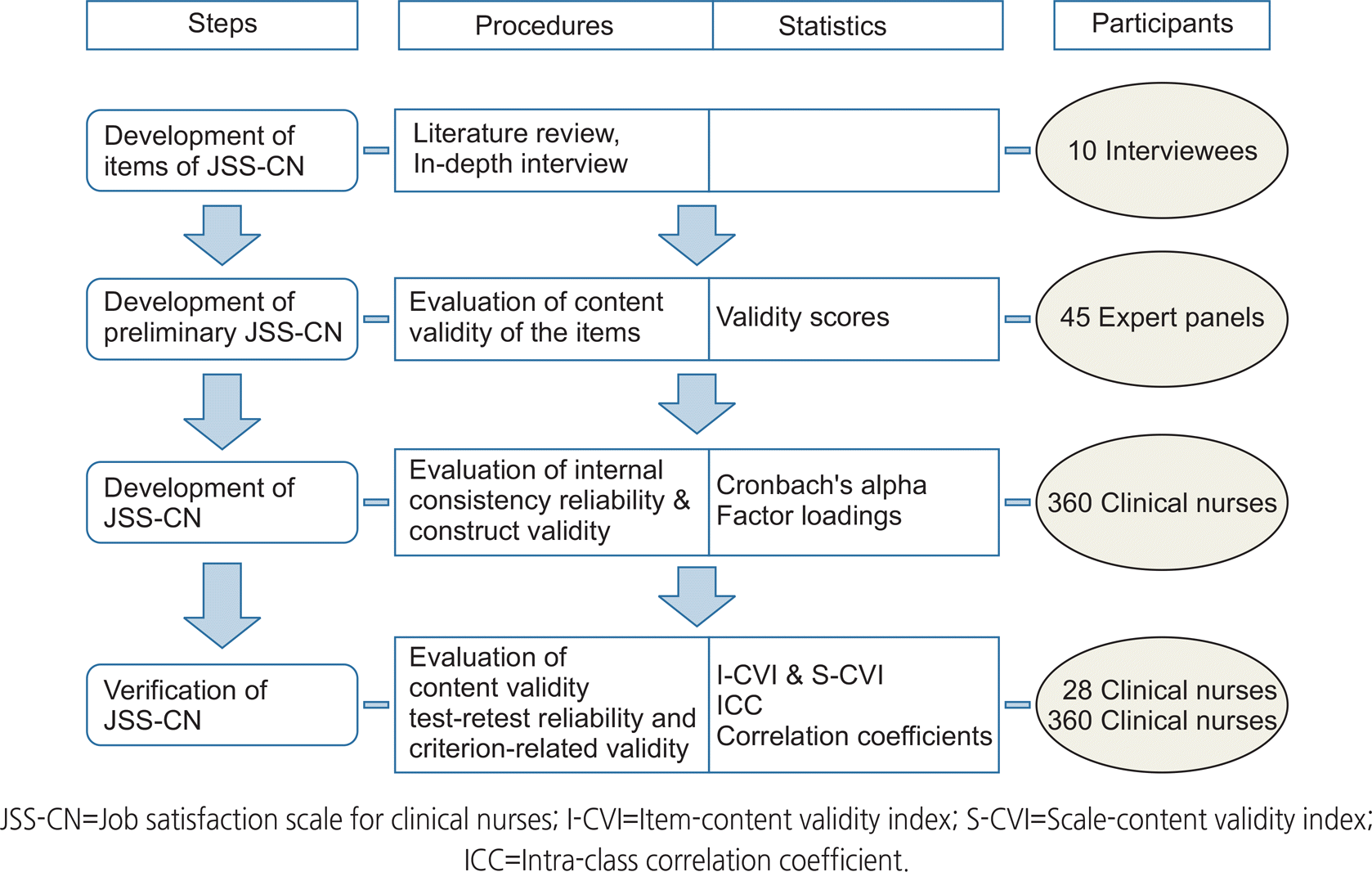1. Lu H, Barriball KL, Zhang X, While AE. Job satisfaction among hospital nurses revisited: A systematic review. International Journal of Nursing Studies. 2012; 49(8):1017–1038. https://doi.org/10.1016/j.ijnurstu.2011.11.009.

2. Moumtzoglou A. The Greek nurses’ job satisfaction scale: Development and psychometric assessment. Journal of Nursing Measurement. 2010; 18(1):60–69. https://doi.org/10.1891/1061-3749.18.1.60.

3. Adam A, Bond S. Hospital nurses’ job satisfaction, individual and organizational characteristics. Journal of Advanced Nursing. 2000; 32(3):536–543. https://doi.org/10.1046/j.1365-2648.2000.01513.x.
4. Fung-kam L. Job satisfaction and autonomy of Hong Kong registered nurses. Journal of Advanced Nursing. 1998; 27(2):355–363. https://doi.org/10.1046/j.1365-2648.1998.00527.x.

5. Song MS. The relationships between the empowerment, nursing performance, job satisfaction and turnover intention of long-term care hospital nurses. Journal of the Korea Academia-Industrial Cooperation Society. 2013; 14(5):2304–2314. https://doi.org/10.5762/KAIS.2013.14.5.2304.
6. Ahn SH. Analysis of studies on job satisfaction among Korean nurses. Journal of Korean Academy of Nursing Administration. 2000; 6(3):319–331.
7. Jeong GS, Jung MS. Job satisfaction among Korean nurses: A literature review. Journal of Muscle and Joint Health. 2013; 20(3):235–246. https://doi.org/10.5953/JMJH.2013.20.3.235.

8. Hayes B, Bonner A, Pryor J. Factors contributing to nurse job satisfaction in the acute hospital setting: A review of recent literature. Journal of Nursing Management. 2010; 18(7):804–814. https://doi.org/10.1111/j.1365-2834.2010.01131.x.

9. Blegen MA. Nurses’ job satisfaction: A meta-analysis of re- lated variables. Nursing Research. 1993; 42(1):36–41. https://doi.org/10.1097/00006199-199301000-00007.
10. Kim JH. Structural equation modeling for humor, job satisfaction, job stress and intention to turnover. Journal of Korean Academy of Nursing Administration. 2013; 19(2):265–272. https://doi.org/10.11111/jkana.2013.19.2.265.

11. Kwon KJ, Chu MS, Kim JA. The impact of nursing professionalism on the nursing performance, job satisfaction and retention intention among clinical nurses. Journal of Korean Academy of Nursing Administration. 2009; 15(2):182–192.
12. Do ES, Kim MY. Comparison of internal marketing, job satisfaction and customer orientation of nurses by size of medical care institution: Small-medium hospitals and general hospitals. Journal of Korean Academy of Nursing Administration. 2012; 18(1):56–66. https://doi.org/10.11111/jkana.2012.18.1.56.

13. Lee BS, Kang SR, Kim HO. Experience of job satisfaction in clinical nurses: Application of focus group methodology. Journal of Korean Academy of Nursing. 2007; 37(1):114–124. https://doi.org/10.4040/jkan.2007.37.1.114.

14. Slavitt DB, Stamps PL, Piedmont EB, Haase AM. Nurses’ satisfaction with their work situation. Nursing Research. 1978; 27(2):114–120.

15. Stamps PL, Piedmont EB, Slavitt DB, Haase AM. Measurement of work satisfaction among health professionals. Medical Care. 1978; 16(4):337–352.

16. Tourangeau AE, McGillis Hall L, Doran DM, Petch T. Measurement of nurse job satisfaction using the McCloskey/Mueller Satisfaction Scale. Nursing Research. 2006; 55(2):128–136.

17. Park SA, Yun SN. Measurement of job satisfaction of nurses and health workers in health centers. Journal of Korean Academy of Nursing. 1992; 22(3):316–324. https://doi.org/10.4040/jnas.1992.22.3.316.

18. Flynn D. Improving continence care: searching the evidence. Journal of Community Nursing. 2005; 19(3):18–25.
19. Lee EO, Im NY, Park HA, Lee IS, Kim JI. Nursing research and statistical analysis. 4th ed. Paju: Soomoonsa;2009. p. 572–578.
20. Lynn MR. Determination and quantification of content validity. Nursing Research. 1986; 35(6):382–385. https://doi.org/10.1097/00006199-198611000-00017.

21. Nunnally JC Jr, Bernstein IH. Psychometric theory. 3rd ed. New York: McGraw-Hill;1994. p. 447–490.
22. Park JH. Organizational communication satisfaction and job satisfaction for nurses in hospital setting [master thesis]. Seoul: Ehwa Womans University;2003. p. 1–73.
23. Shin SC. Development of evaluation tool for hospital nurses [dissertation]. Daegu: Keimyung University;2002. p. 1–79.
24. Polit DF, Beck CT. The content validity index: Are you sure you know what’s being reported? Critique and recommenda- tions. Research in Nursing & Health. 2006; 29(5):489–497. https://doi.org/10.1002/nur.20147.
25. Terwee CB, Bot SD, de Boer MR, van der Windt DA, Knol DL, Dekker J, et al. Quality criteria were proposed for measurement properties of health status questionnaires. Journal of Clinical Epidemiology. 2007; 60(1):34–42. https://doi.org/10.1016/j.jclinepi.2006.03.012.

26. Koo TK, Li MY. A guideline of selecting and reporting intra-class correlation coefficients for reliability research. Journal of Chiropractic Medicine. 2016; 15(2):155–163. https://doi.org/10.1016/j.jcm.2016.02.012.

27. Ko MS, Min S, Yeom YH, Yeun SH, Lee MA, Jung M, et al. Introduction of nursing. 3rd ed. Paju: Soomoonsa;2011. p. 65–117.
28. Mueller CW, McCloskey JC. Nurses’ job satisfaction: A proposed measure. Nursing Research. 1990; 39(2):113–117. https://doi.org/10.1097/00006199-199003000-00014.
29. Cowin L. The effects of nurses’ job satisfaction on retention: An Australian perspective. Journal of Nursing Administration. 2002; 32(5):283–291. https://doi.org/10.1097/00005110-200205000-00008.




 PDF
PDF ePub
ePub Citation
Citation Print
Print



 XML Download
XML Download